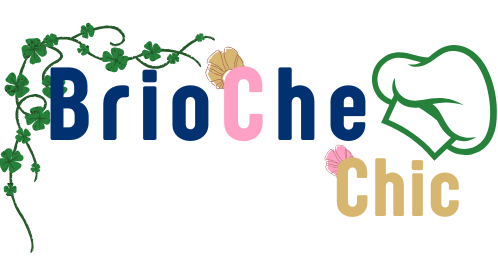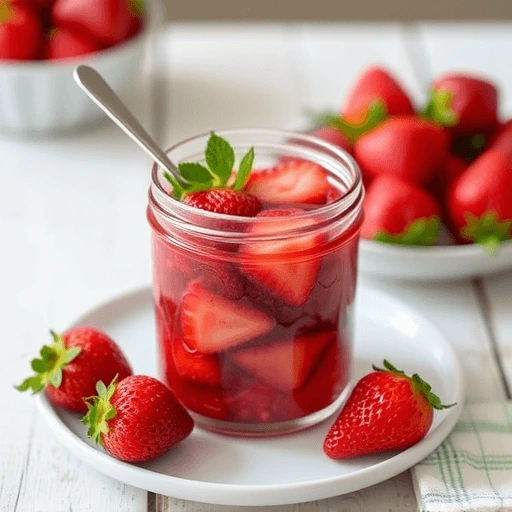perfect strawberry jam
There’s something deeply nostalgic about the scent of bubbling strawberries in a pot. As the fruit softens and the natural sugars begin to caramelize, the kitchen fills with a perfume that speaks of warm days, garden harvests, and quiet mornings at the breakfast table.
At Brioche Chic, we cherish traditions that turn the everyday into something truly special. Making your own strawberry jam is exactly that — a moment of slow living, of working with your hands and heart to create something beautiful and lasting.
This preserve is not merely a spread. It’s a memory. A spoonful of sun-ripened fruit, carefully cooked to capture its purest expression, then sealed in glass to be savored through the seasons. Whether served on buttery toast, nestled in a tender pastry, or gifted with a handwritten label, it brings elegance and warmth to any table.
In this post, I’ll guide you through the process step by step, with all the little chef secrets that make the difference — the right texture, the perfect shine, and that fresh taste that store-bought jam can never quite replicate.
Let’s preserve more than fruit — let’s preserve the joy of making things with love.
Strawberry Jam – Capturing Summer in a Jar
There’s something deeply nostalgic about the scent of bubbling strawberries in a pot. As the fruit softens and the natural sugars begin to caramelize, the kitchen fills with a perfume that speaks of warm days, garden harvests, and quiet mornings at the breakfast table.
At Brioche Chic, we cherish traditions that turn the everyday into something truly special. Making your own strawberry jam is exactly that — a moment of slow living, of working with your hands and heart to create something beautiful and lasting.
This preserve is not merely a spread. It’s a memory. A spoonful of sun-ripened fruit, carefully cooked to capture its purest expression, then sealed in glass to be savored through the seasons. Whether served on buttery toast, nestled in a tender pastry, or gifted with a handwritten label, it brings elegance and warmth to any table.
Let’s preserve more than fruit — let’s preserve the joy of making things with love.
Recipe Overview
- Yield: 3 jars of 500 g each
- Preparation Time: 45 minutes
- Cooking Time: Variable (depending on temperature and method)
- Shelf Life: Up to 3 months at room temperature, in properly sterilized jars
Equipment Needed
- A stainless steel or tin-lined copper jam pan
- A candy or jam thermometer
- A skimmer (écumoire)
- 3 glass jars of 500 g capacity, sterilized and ready to use
Ingredients
- 1 kg fresh strawberries
- 600 g caster sugar (crystal sugar)
- 300 g water
- 6 g pectin NH
- 100 g granulated sugar (for mixing with pectin)
- 10 g lemon juice
Method – Step by Step
- Prepare the strawberries:
Wash and drain the strawberries carefully. Pat them completely dry with a clean cloth or paper towel. Remove the stems. Cut the larger berries in half and leave the smaller ones whole for a beautiful, rustic texture. - Start the syrup:
In a copper jam pan (or stainless steel if preferred), combine the caster sugar and water. Bring the mixture to a boil and cook until it reaches 120 °C (248 °F) — this stage will create a light syrup that helps preserve the shape of the fruit.
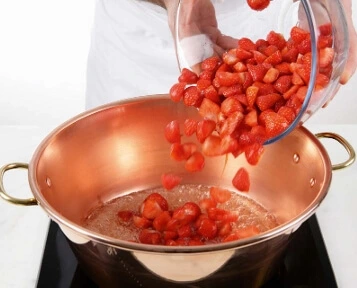
- Add the strawberries:
Once the syrup reaches the desired temperature, gently add the prepared strawberries. Let them simmer and skim off any foam that forms on the surface. This step ensures a clear, glossy finish.
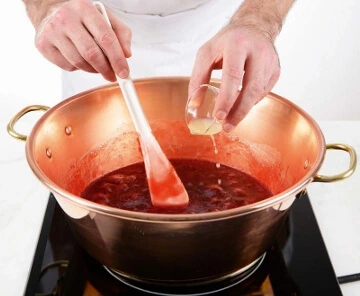
- Incorporate the pectin:
In a separate bowl, mix the pectin NH with the granulated sugar. Gradually sprinkle this mixture over the simmering fruit while stirring to prevent lumps. Continue cooking until the jam reaches 104 °C (219 °F) — the ideal setting point for a rich yet spreadable consistency.
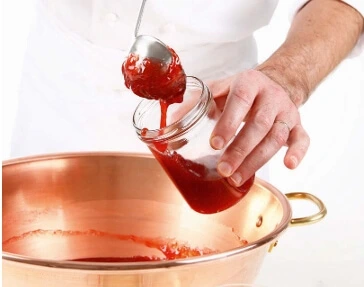
- Finish the jam:
Once the desired temperature is reached, remove from the heat and immediately stir in the fresh lemon juice. This not only enhances the flavor but also helps stabilize the texture. - Jar and seal:
Pour the hot jam into clean, sterilized jars. Seal immediately, then turn the jars upside down to create a vacuum. Let them cool completely before storing.
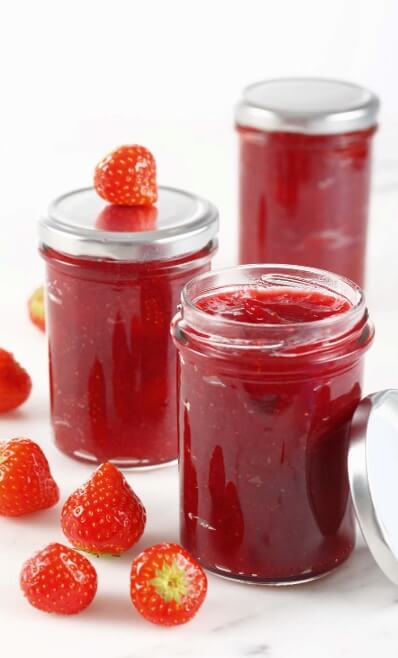
Chef’s Tips & Tricks
• Work in small batches – For the best flavor and texture, always prepare your jam in batches of 1 kg of fruit. This allows for better control over cooking and ensures the fruit keeps its integrity.
• Mix pectin with sugar first – To avoid clumps and ensure an even distribution, always combine the pectin with the granulated sugar before adding it to the mixture. Incorporate it just before boiling, while the fruit is still heating — this activates the gelling power without overcooking the fruit.
Final Thoughts
Making strawberry jam is more than just a culinary task — it’s a gesture of care, of patience, and of timeless tradition. It’s the quiet joy of watching fruit transform, little by little, into something that will brighten many mornings and desserts to come. A jar of homemade jam isn’t just a preserve — it’s a story. A story of ripened fruit, of careful hands, and of a moment taken to honor the season.
By following this method and these chef-tested tips, you’re not only crafting a delicious preserve — you’re also reviving a ritual that has long been passed down through generations. The gleam of a well-cooked jam, the subtle balance of sweetness and acidity, the satisfying ‘pop’ of a jar being opened — all of it speaks of authenticity and elegance.
Whether you choose to keep your jars for weekend breakfasts, pair them with warm scones, or offer them as gifts wrapped in ribbon and linen, know that what you’ve created is far more than a simple spread. You’ve captured summer in a jar — with love, intention, and a touch of French savoir-faire.
So here’s to slow mornings, shared moments, and the quiet luxury of homemade things
Questions & Answers
Q: Can I reduce the amount of sugar in this recipe?
A: It’s not recommended, especially when working with pectin NH. The sugar helps the jam set properly and acts as a natural preservative. If you reduce it, the texture and shelf life may be affected.
Q: Can I use frozen strawberries instead of fresh?
A: Yes, you can. Be sure to thaw and drain them well before use. Keep in mind that frozen berries may release more water, so adjust cooking time slightly to achieve the desired consistency.
Q: Why is my jam too runny or too firm?
A: The setting depends on precise temperature and correct use of pectin. If your jam is too runny, it may not have reached 104 °C. If too firm, it might have been cooked a little too long or contained too much pectin. Always use a thermometer and test on a cold plate.
Q: How should I store the jars after making the jam?
A: Store in a cool, dry place away from direct sunlight. Once opened, keep in the fridge and consume within a few weeks.
Q: Can I double the recipe?
A: For best results, stick to small batches (1 kg of fruit). Larger quantities are harder to control in terms of cooking time and temperature, and may affect the final texture and flavor.4 Secret to Perfect Brioche: Chef’s Tips Revealed Guide to French Preserving Traditions http://Guide to French Preserving Traditions – Saveurs Magazine (FR)
